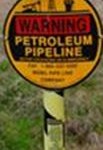 Citizens in East Texas are becoming alarmed as representatives from ExxonMobil, operator of the Pegasus pipeline, show up to post yellow and black-striped warning markers along the pipeline route running across their land, the same one that ruptured about 320 miles northeast of there in March, spewing at least 210,000 gallons of heavy Canadian crude into neighborhood streets in Mayflower, Ark. Click here to read the article by the Texas Tribune that documents how normally conservative landowners are turning into activists in defense of their land and their homes.
Citizens in East Texas are becoming alarmed as representatives from ExxonMobil, operator of the Pegasus pipeline, show up to post yellow and black-striped warning markers along the pipeline route running across their land, the same one that ruptured about 320 miles northeast of there in March, spewing at least 210,000 gallons of heavy Canadian crude into neighborhood streets in Mayflower, Ark. Click here to read the article by the Texas Tribune that documents how normally conservative landowners are turning into activists in defense of their land and their homes.
Posts Tagged ‘tarsands’
East Texans Seek Shutdown of Pegasus Pipeline – turning conservatives into activists
Posted in Air Quality, pipelines, Property Rights, Tarsands, tagged #nokkl, conservatives, East Texas, exxonmobil, keystone xl, Pegasus, Pegasus Pipeline, tarsands, Texas on November 11, 2013 |
Pipeline spill in Arkansas calls into question conversion of older pipelines for transporting tarsands
Posted in Global Warming, Tarsands, tagged exxonmobil, Heavy crude oil, Mayflower Arkansas, Oil sands, tarsands, Texas on April 2, 2013 |
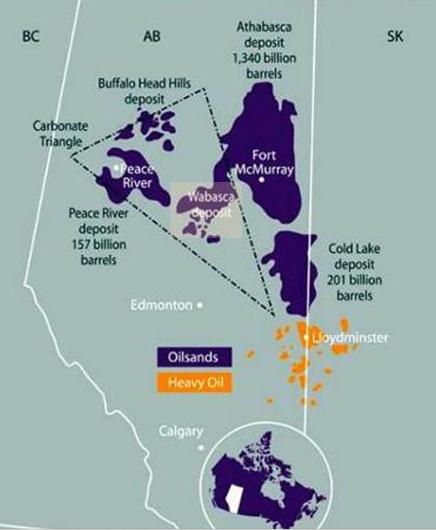
Canadian Oil Sands: Location of Canadian oil sands and viscous heavy oil deposits (Source: Canadian Association of Petroleum Producers (CAPP) website at http://www.canadasoilsands.ca/en/)
On Good Friday, an ExxonMobil pipeline carrying Canadian Wabasca Heavy crude burst in Mayflower, Arkansas and was discovered—not by the pipeline company—but by a local resident. According to the Canadian Energy Pipeline Association (CEPA), which referred to Wabasca as “oil sands” in a report, the “heavy crude” is a heavy bitumen crude diluted with lighter liquids (or diluted bitumen also called dilbit) to allow it to flow through pipeline. So we will be referring to the spill as oil sands to differentiate it from crude oil.
Exxon Mobil Corp continues its efforts to clean up thousands of barrels of Canadian tarsands spilled from a 65-year-old pipeline in Arkansas, as a debate rages about the safety of transporting rising volumes of the fuel into the United States.
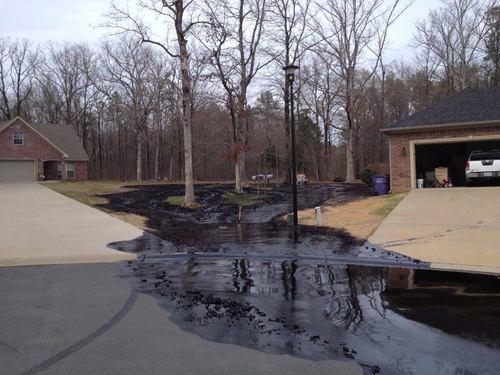
Oil Sands spilling from Exxon pipeline, March 29, 2013 – http://switchboard.nrdc.org/blogs/aswift/tar_sands_pipeline_safety_risk.html
The Pegasus pipeline, which ruptured in a community near the town of Mayflower, spewing oil sands across lawns and down residential streets, remains shut and Exxon didn’t begin excavating the area around the breach until Monday, a critical step in assessing damage and determining how and why it leaked. And no reports we have seen indicate the community was alerted to the potential health impacts the residents might experience.
Exxon Mobil’s Pegasus pipeline crosses 13 miles of the Lake Maumelle watershed. Many are concerned this poses a risk to Central Arkansas’s water supply, which includes the drinking water for Little Rock, the capital and the largest city of the state of Arkansas
The spill has stoked a discussion about the environmental dangers of using aging pipelines to transport dilbit from Canada, as a boom in oil and gas production in North America increases volumes moving across the continent. The Pipeline and Hazardous Materials Safety Administration (PHMSA) said in a recent report that more than half of the nation’s pipelines were built in the 1950s and 1960s in response to higher energy demand after World War II. This is of particular interest to East Texans who may become host to hundreds of miles of re purposed Seaway pipeline that, like the Arkansas pipeline, passes near three major DFW water supplies.
Environmentalists argue that oil sands are more corrosive to pipelines than conventional oil and that spills from these pipelines pose a risk to drinking supplies and the health of residents living near a spill.
A 2010 Michigan spill resulted in residents being evacuated up to six miles away with more than 60% of the local population complaining of illness. (Source: Michigan Messenger,July, 2010) In a spill of oil sands, high levels of benzene and hydrogen sulfide go airborne requiring evacuation.
A film crew from the DFW area doing a documentary on the Tarsands fight, that traveled with a group of Texans to the Climate Rally in DC in February, were quickly dispatched after the Arkansas spill was discovered. They have shared with environmental groups that while filming in a local elementary school not far from the spill, numerous children at the school were reporting bouts of vomiting.
Children living near the Michigan spill reported cases of vomiting, upset stomach, shortness of breath, lethargy, headaches, rash, irritation with the eyes, sore throat, and cough withing the first week. Adults experienced migraines, eye irritation, sore throat, nausea, and coughing, and pets suffered from continuous vomiting and diarrhea. While the pipeline company told residents that they couldn’t prove that the pipeline spill was the cause, the EPA established that there were 15 parts per billion of benzene in the atmosphere in the region of the spill, which is roughly three times the standard established as safe for human exposure.
And to add insult to injury, this community found out after the fact that, while companies that transport oil are required to pay into the Oil Spill Liability Trust Fund, giving the government a pot of money for immediate spill responses, the Enbridge pipeline in Michigan and the Exxon pipeline in Arkansas, are exempt because these pipelines are not considered to be carrying “conventional oil”, despite the fact bitumen spills are more expensive and more dangerous.
So after 3 years, the Michigan spill is far from being cleaned up, and the long term affects of exposure to the toxins released from the spill won’t be known for years. We can only anticipate that the Arkansas community will experience similar issues in cleanup efforts and Little Rock will wait to see if there are going to be impacts on their water resources.
Texans along the pipeline routes have expressed many of these concerns over the past year fighting the tar sands pipeline companies that want to run these through their lands and here are a few things that they have learned.
Despite tar sands unique properties of high pressure, high transport temperatures, higher acidic, sulfuric, and chemical content, these pipelines are built to conventional crude pipeline standards and in Texas:
- Emergency response plans are only required after a pipeline company begins operations, not before.
- Pipeline testing is self-determined by industry for both new and re-purposed pipelines.
- The Railroad Commission has few inspectors to check pipeline integrity. Companies only propose flyover inspections of these lines every two weeks.
- Pipelines travel through rural areas, are considered low consequence, so are not given the same safety considerations as more populated, high consequence areas.
- Volunteer fire departments in rural areas lack the expertise, training and equipment to deal with a tar sands spill which is a hazardous material spill
- Computerized detection system tout spotting pipeline problems within 10 minutes, but this has failed with both new and re-purposed pipeline spill detection.
I certainly don’t feel like the government has my best interest at heart looking at these failures to protect the citizens of Texas and other states along these pipeline routes. We will be watching this one.
Rerouting Keystone XL: From Poisoned Aquifers to Polluted Land
Posted in Air Quality, Water, tagged keystone, pipeline spills, tarsands, Texas on December 7, 2011 |
This is a guest blog by departing Public Citizen intern Chantelle B.
In recent months, Nebraska’s government has taken a strong stand against the Keystone XL Pipeline’s route, which currently passes through the ecologically fragile Sandhills region and North America’s largest aquifer – the Ogallala – which, if polluted, could have disastrous effects. The majority of this aquifer lies under Nebraska, and provides the state with 70% of its freshwater. But the Ogallala aquifer’s importance goes beyond Kansas. It is one of the most important sources of water in the Plains Region, used for residential and industrial purposes as well as agriculture, the base of the economy in the area. Texas is one of the leading states irrigating from the aquifer, accounting for about 40% of Texas’ water use. Officials in the Nebraskan State government, such as Governor David Heinman, have signed a bill to ensure that TransCanada will not be able to build their behemoth of a Pipeline through the precious Sandhills region.
On November 10th, President Obama delayed the date for granting TransCanada a permit to construct the Pipeline across the U.S.-Canada border until after the 2012 Presidential elections. One component of the President’s decision to postpone the Pipeline’s construction was to ensure a Department of State-approved rerouting that satisfies Nebraska’s demands. Unfortunately for the environment, Nebraskans are showing a proclivity to support the Pipeline generally, and only stress the environmental importance of the delicate Ogallala and Sandhills region. TransCanada is set to collaborate with the Nebraska department of environmental quality and the DoS, which will audit its alternate route to ensure it avoids the regions in question, making it only marginally more environmentally sound. However, TransCanada’s President for Energy and Oil Pipelines, Alex Pourbaix, still affirms his belief that the Pipeline would have been equally safe even if the original route were implemented.
Although a new route will protect the most ecologically sensitive locations in Nebraska, there remains the problem that a daughter project already in play, the Keystone 1 Pipeline in the northern Great Plains, has already exceeded its projected spill figures. Despite TransCanada’s prediction that this smaller pipeline would spill around 11 times throughout its lifetime of approximately 50 years, it has already had more than it’s lifetime number of spills within its first year of operation. So while the Sandhills region and Ogallala may be spared from catastrophe the land traversed in the new route will still be subject to as devastating a fate, like the 6 story geyser of diluted bitumen seen in the worst Keystone 1 spill.
Everyone in the way of this pipeline should become aware of the history of ecological damage these types of pipelines have already experienced. And those of us near the terminous – where heavy crude oil refineries may be gearing up to refine this most polluting of all crudes, spilling more toxins into the air around Houston, Beaumont and Port Arthur, TX or the ports will load large ships with the diluted bitumen and send them out into the Gulf of Mexico – well, we have other pollution worries to consider.
How Many Tar Sands Pipeline Spills Does Texas Want?
Posted in Tarsands, tagged david daniel, keystone, pipeline, sands, spill, stop, tar, tarsands, Texas, XL on June 6, 2011 |
U.S. Stops Keystone I Line from Restarting After 12th Spill in 12 Months, Days Before Comment Period Ends on Keystone XL
For over a year, TransCanada has been trying to get its hands on a Presidential Permit from the U.S. Department of State to extend its Keystone I tar sands pipeline with a pipeline called Keystone XL. That extension would start in Alberta, Canada, link on to Keystone I in the Midwest and attach on its Southern end in Oklahoma before it heads through Texas and ends at Gulf Coast refineries. During this same year, though, TransCanada’s Keystone I line has been leaking at an alarming rate.
It’s a fact that tar sands pipelines leak at 16 times more per mile due to internal corrosion, and something that has long been a concern of citizens opposed to the Keystone XL line slated to come through Texas. Today, though, TransCanada’s inability to operate Keystone I without averaging less leaks than one per month has finally gotten to the Department of Transportation (DOT) and United States Pipeline and Hazardous Materials Safety Administration (PHMSA) who today issued an order of corrective action against TransCanada.
TransCanada’s Keystone I line sprung its twelfth leak in nearly twelve months last weekend in Kansas to the tune of 2,100 gallons, only two weeks after a 21,000 gallon leak in North Dakota and ten other smaller leaks.
PHMSA’s statement today notified the public that “Effective immediately, this order prevents TransCanada from restarting operations on their Keystone crude oil pipeline until PHMSA is satisfied with the ongoing repairs and is confident that all immediate safety concerns have been addressed. PHMSA issued the order in connection with two incidents in May involving oil leaks from small diameter pump station pipe fittings,” and DOT’s official letter to TransCanada also reads that “the continued operation of the pipeline without corrective measures would be hazardous to life, property and the environment.”
This corrective order from PHMSA comes just three days before the 45-day comment period on Keystone XL’s Supplemental Draft Environmental Impact Statement (SDEIS) ends on Monday, June 6th.
STOP Founder and President David Daniel had the following to say: “The deck of evidence is stacked against TransCanada. It would be absolutely absurd for the State Department to permit Keystone XL now. The EPA spoke out against Keystone XL’s Draft Environmental Impact Statement and now PHMSA is having to step in to protect citizens from TransCanada’s Keystone I line. For the State Department to allow Keystone XL to go through would be a slap in the face to not only these agencies but to the concerns and livelihoods of millions of Americans, as it too would be, in the Department of Transportation’s own words ‘hazardous to life, property, and the environment.’ TransCanada cannot keep getting away with this. We ask the State Department to take the Department of Transportation’s action today as a warning and say no to a Presidential Permit for Keystone XL.”
To make comments on the Draft Environmental Impact Statement, you can visit http://www.keystonepipeline-xl.state.gov/clientsite/keystonexl.nsf?Open or contact STOP at bdmcallister@stoptarsands.org or 409.550.7961 for more information.
Major Oil Spill From Keystone Pipeline
Posted in Tarsands, tagged canada, cogswell, Eminent Domain, geyser, keystone, north dakota, pipeline, rupture, spill, Tar Sands, tarsands, Texas, transcanada, XL on May 10, 2011 |
On Saturday, May 7 the Keystone pipeline had a major rupture and spill near Cogswell, North Dakota spewing 500 barrels of oil in a geyser twice the height of the surrounding trees (about 60 feet). This pipeline is owned by TransCanada, the same company proposing to build the Keystone XL pipeline (an extension of the Keystone pipeline) down through Oklahoma and Texas.
Here is a video from WDAY Channel 6 out of Fargo, North Dakota covering the spill. The pipeline spill was the lead story.
What this video doesn’t cover is that this was not ordinary crude oil, but rather a far more toxic and dangerous substance called “tar sands” oil, mined in the vast tar sands strip mines in Alberta, Canada. It should also be remembered that this pipeline is only a year old (more or less brand new) and has already had 10 other “small” spills. Such a deplorable record should be sending off massive alarm bells for the expansion project proposed for Texas.
TransCanada is a private, foreign (Canadian) company which has been granted, for some reason, powers of eminent domain throughout the US – including Texas. This company has been using the threat of this power to bully landowners into signing contracts they do not want to sign. The permit for their expansion project, the Keystone XL, is still pending at the State Department. In light of this recent spill there is no way the state department should consider granting this irresponsible and reckless company the ability to further endanger the lives and well-being of Texans and US citizens.
As Alex Moore with Friends of the Earth recently stated, “Nobody should have to wake up on a Saturday morning to the sight of oil spraying 60 feet into the air near her home.”
For more information on tar sands and what makes it the “dirtiest oil on the planet,” see some of our previous blog posts on the subject:
Is my property ripe for the TAKING?
Posted in Air Quality, Tarsands, tagged Condemnation, Eminent Domain, keystone, Oil sands, Takings, tarsands, Texas on October 7, 2010 |
As you may have read in an earlier blog, Texas landowners who live in the path of the proposed Keystone Pipeline route may be dealing with the threat of eminent domain to force them into a contract. If the landowner doesn’t come to an agreement with the entity intent on “taking” their land, then they might be put in the position of hiring an attorney to fight condemnation proceedings against their property in court. If you think you might be facing such a fight, we thought we’d post what we know about this process. (more…)
Tar Sands Oil’s Devastating Legacy
Posted in Air Quality, Energy, Global Warming, green jobs, natural gas, Renewables, Tarsands, Toxics, tagged canada, climate change, dirty, Energy, Global Warming, Keystone Pipeline, oil, Oil sands, Oklahoma, pipeline, Public Citizen, public citizen texas, Tar Sands, tarsands, Texas, transcanada on September 24, 2010 |
 Tar sands oil makes conventional oil look clean by comparison, as it produces 3.2-4.5 times more the carbon footprint than conventional fuel. If that weren’t bad enough cleaner fuels such as natural gas, which otherwise might be used to generate electricity, are wasted in the process of creating more dirty energy from tar sands. Tar sands oil is a type of bitumen deposited in a semi solid form whose extraction is an extremely energy intensive project. For every third barrel of oil extracted one has effectively been consumed by the process. The process of tar sands oil extraction has left vast tracts of land barren with little vegetation as it is strip mined; while only 10%, of what is excavated, is oil. While some water is recyclable, the remaining toxic water is diverted to the euphemistically named “tailing ponds”. There are 2.5-4 barrels of water dumped into these toxic lakes for every barrel of oil extracted. These toxic “ponds” are actually very large; some are even visible from space.
Tar sands oil makes conventional oil look clean by comparison, as it produces 3.2-4.5 times more the carbon footprint than conventional fuel. If that weren’t bad enough cleaner fuels such as natural gas, which otherwise might be used to generate electricity, are wasted in the process of creating more dirty energy from tar sands. Tar sands oil is a type of bitumen deposited in a semi solid form whose extraction is an extremely energy intensive project. For every third barrel of oil extracted one has effectively been consumed by the process. The process of tar sands oil extraction has left vast tracts of land barren with little vegetation as it is strip mined; while only 10%, of what is excavated, is oil. While some water is recyclable, the remaining toxic water is diverted to the euphemistically named “tailing ponds”. There are 2.5-4 barrels of water dumped into these toxic lakes for every barrel of oil extracted. These toxic “ponds” are actually very large; some are even visible from space.
Needless to say these pools are quite harmful to surrounding ecosystems as well as ground water supplies. The land left behind from tar sands extraction is a barren wasteland lacking vegetation and dotted with these toxic waste pools. Not only is the devastation comprehensive, it is widespread. Tar sands extraction in Alberta, Canada is set to affect an area the size of Florida.
Pipelines bringing this dirty oil to the United States have already been built, but TransCanada, an extractor of tar sands oil, has proposed to expand the pipeline system. Part of the proposed expansion will link to a current pipeline in Oklahoma and extend it into East Texas and the Houston Bay Area so that it might be refined there. These refineries will require expensive additions to handle this heavy crude. The planned route crosses through Texas and Oklahoma over rivers, through national forests, and across private land. Landowners have been threatened with eminent domain if they do not comply with Keystone’s demands. Keystone XL clearly places finance over environmental safety as they applied for (then temporarily withdrew) an application for exemptions to the rules that would allow them to make the pipe thinner in rural areas and yet pump at above currently permissible levels. However, they may reapply for this “special permit” later as they seek lower costs at the expense of the public. We cannot allow this to happen. The social costs of tar sands oil production is far too high and the benefits far too small. The expansion of this extremely dirty energy undermines what progress has been made in cleaning America’s energy consumption. While we should be cultivating clean energy production, the dirtiest energy production is being expanded.
Keystone XL needs a presidential permit to build this international pipeline. This is a point of vulnerability. Throughout the summer Public Citizen has been organizing individuals and groups to attend various meetings, hearings, and conferences. The U.S. State Department has held public hearings on its Draft EIS and we have urged others to take the opportunity to raise their voice.
Our efforts at getting such groups together continue as we move further down the proposed pipeline into the Houston area, reactivating allies and making new ones as we work together to stop a pipeline that is proposed to travel near sensitive areas such as the Big Thicket National Preserve. This pipeline only adds to Texas’ clean air problems and by stopping it in Texas we can change the momentum on a rapidly growing dirty industry. Future infrastructure development should be dedicated to renewable, clean energy – not dirtier energy than what we already have.
###
By promoting cleaner energy, cleaner government, and cleaner air for all Texans, we hope to provide for a healthy place to live and prosper. We are Public Citizen Texas.
Dirtiest Oil in the World to be Refined in Texas?
Posted in Energy, Global Warming, Transportation, tagged canada, deis, draft environmental impact statement, Global Warming, hearings, meeting, oil, pipeline, state department, Tar Sands, tarsands, Texas on June 29, 2010 |
 TransCanada, a pipeline company out of Canada, wants to build a pipeline to bring the dirtiest kind of oil in the world from tar sands mines in Alberta, Canada to refineries in Houston and Beaumont. This oil is many times dirtier than conventional crude and allowing Houston area refineries to process it would increase air pollution throughout the region. The tar sands mines in Alberta are devastating the Boreal forest ecosystem, laying waste to a region the size of Florida and poisoning the people who live downstream. The first permit this pipeline needs is the Presidential Permit, which goes through the State Department. The comment period on this project is open until July 2 – to submit comments online go here. For more information on tar sands oil visit dirtyoilsands.org and to stay updated on tar sands news in Texas keep coming back here to Texas Vox, and visit our main webpage on tar sands here. (more…)
TransCanada, a pipeline company out of Canada, wants to build a pipeline to bring the dirtiest kind of oil in the world from tar sands mines in Alberta, Canada to refineries in Houston and Beaumont. This oil is many times dirtier than conventional crude and allowing Houston area refineries to process it would increase air pollution throughout the region. The tar sands mines in Alberta are devastating the Boreal forest ecosystem, laying waste to a region the size of Florida and poisoning the people who live downstream. The first permit this pipeline needs is the Presidential Permit, which goes through the State Department. The comment period on this project is open until July 2 – to submit comments online go here. For more information on tar sands oil visit dirtyoilsands.org and to stay updated on tar sands news in Texas keep coming back here to Texas Vox, and visit our main webpage on tar sands here. (more…)
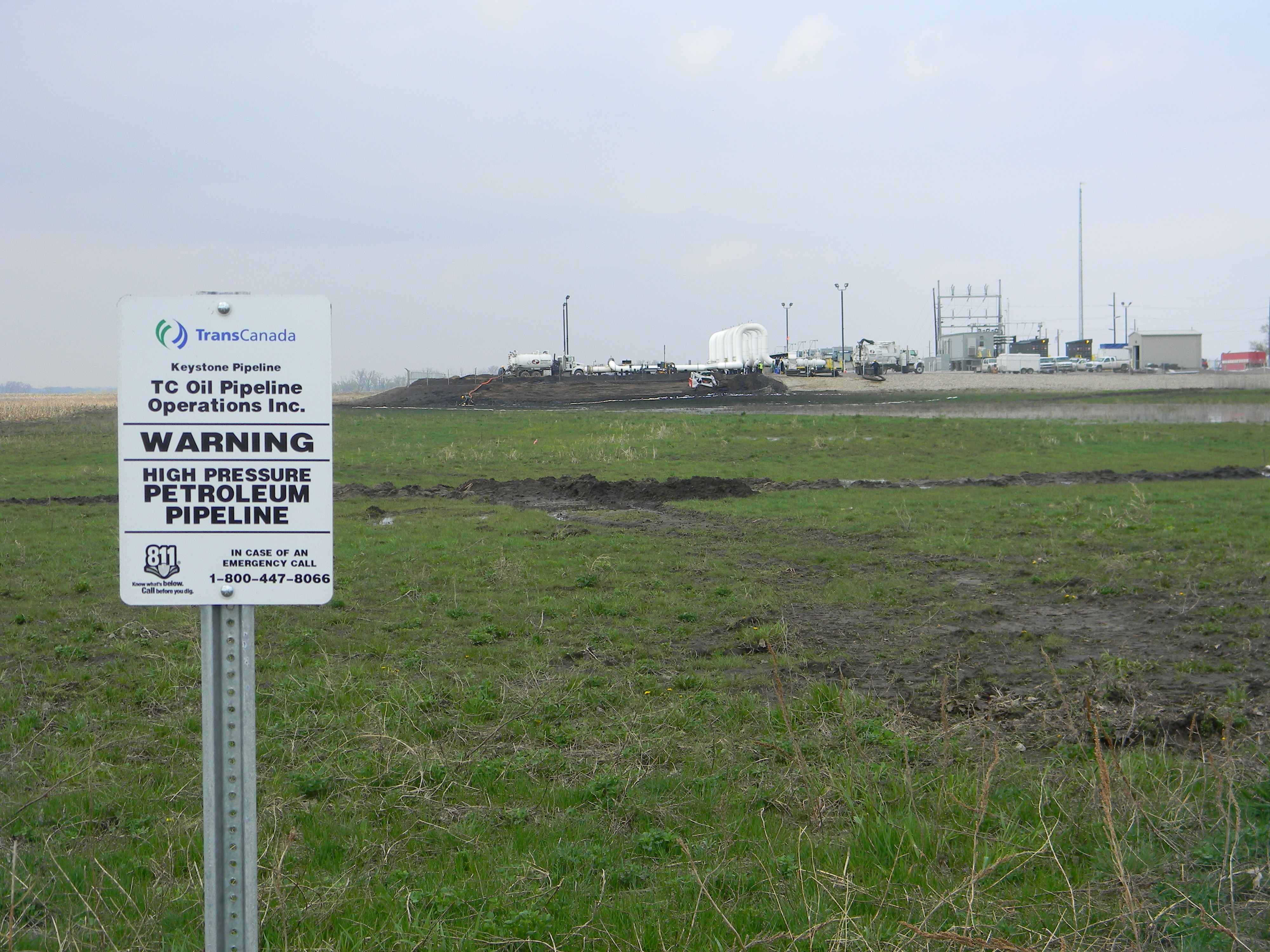
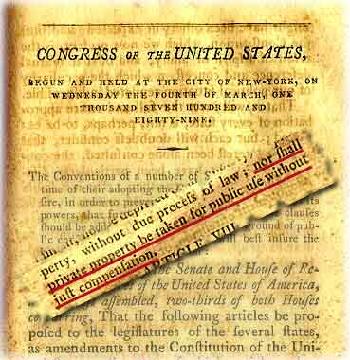



Massive Opposition to Tar Sands Pipeline
Posted in Tarsands, tagged comments, keystone, keystone xl, permit, pipeline, spill, state department, Tar Sands, tarsands, Texas, transcanada on June 9, 2011 |
Check out KETK for their recent story on the spill and overview of the project.
The State Department will decide soon on whether or not to grant this project the necessary “presidential permit” it needs for construction from Canada down through the central US. The future of energy lies in renewable energy – and that is where we should be investing in new infrastructure. This pipeline takes us in exactly the opposite direction towards a dirtier and more destructive fossil fuel. Contact your congressman and ask them to pressure the White House and State Department not to grant this permit.
http://whoismyrepresentative.com/
Read Full Post »